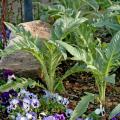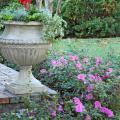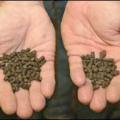News From 2007
By Norman Winter
MSU Horticulturist
Central Mississippi Research & Extension Center
Once a year, the horticulturists from Mississippi State University travel around to see how the nursery industry is doing and brainstorm how we can help. While touring Mynelle Gardens in Jackson, an old spotted aucuba caught my eye.
Mynelle Gardens is undergoing restoration, and you can see exciting plans being put into place everywhere. If you've never been there, think about making a trip to the gardens this spring during the azalea and dogwood season.
MISSISSIPPI STATE -- Peanuts growers will have the opportunity to learn more about their industry from a range of experts during a daylong event in January.
The Mississippi Peanut Growers’ Association meeting and peanut short course is Jan. 22 at the Mississippi State University Extension Service office in Hattiesburg. Registration is free, but preregistration is requested by Jan. 15. The Extension Service is hosting the event, and lunch will be provided.
MISSISSIPPI STATE -- Consumers are concerned with meat quality at the point of purchase and until use, but those bringing the meat to market must manage numerous factors before it reaches the customer.
“My research is on improving meat quality through pre-harvest intervention,” said Ty Schmidt, a researcher with the Mississippi Agricultural and Forestry Experiment Station. “This includes animal management, nutrition, nutritional manipulation, health, animal welfare and stress physiology. Each of these factors impacts meat quality and food safety.”
MISSISSIPPI STATE -- World demand for nitrogen, phosphorus and potassium has driven the price of these fertilizers past record levels, and Mississippi producers are trying to make 2008 crop decisions in light of steadily rising costs.
Improved market prices promoted record corn acreage in 2007. Corn acreage in Mississippi went from 340,000 in 2006 to 960,000 in 2007. However, corn generally requires more fertilizer inputs than the other major row crops.
By Norman Winter
MSU Horticulturist
Central Mississippi Research & Extension Center
Sometimes we take for granted native plants and forget about the outstanding attributes they bring to the landscape. One example is the parsley-leaved hawthorn.
My office is located at Hinds Community College, and the campus here is a virtual arboretum. Every tree and shrub looks as though it was part of a plan, and winter color from berry-producing plants was definitely in the design.
MISSISSIPPI STATE -- A Jan. 11 conference will help farmers, landowners, accountants and other consultants learn about current policy issues that can impact revenue and wealth management for today’s farmers and future generations.
The Richard C. Adkerson School of Accountancy at Mississippi State University will present an Agriculture Wealth Management, Accounting and Taxation Conference in the Capps Center at the Delta Research and Extension Center in Stoneville.
MISSISSIPPI STATE -- Poultry is expanding its lead as Mississippi's No. 1 agricultural commodity with an estimated value of $2.3 billion in 2007.
John Anderson, agricultural economist with Mississippi State University's Extension Service, is predicting a 20 percent increase in the state's poultry value over 2006. Forestry, the state's second-biggest agricultural commodity, decreased 8 percent to $1.1 billion.
MISSISSIPPI STATE -- Corn, wheat and grain sorghum in Mississippi posted triple-digit increases in 2007, and corn yielded near a record high as it topped cotton to reach an estimated value of $438 million.
MISSISSIPPI STATE -- Soybeans have snatched the No. 3 spot among the state's top agricultural commodities from cotton, long-heralded among the row crops as king in Mississippi.
Poultry remained in first place among all agricultural commodities with a value of $2.3 billion, and forestry was second at $1.9 billion.
MISSISSIPPI STATE -- The combined influences of a poor housing market and lingering effects of Hurricane Katrina kept the timber industry down in Mississippi, with the estimated value of forestry falling more than 8 percent to $1.1 billion in 2007.
In 2005, the year Katrina hit, the state posted a record-high forestry value of $1.4 billion. That value dropped to $1.2 billion in 2006 before falling further the next year. Despite the declines, timber retains its place as Mississippi's No. 2 agricultural commodity, behind poultry.
By Patti Drapala
MSU Ag Communications
MISSISSIPPI STATE -- High production cost and better marketing opportunities for grain crops have ended cotton's perennial run in the top three of Mississippi's agricultural commodities.
Cotton's value in 2007 is almost $415 million, which places the commodity behind soybeans ($511 million) and corn ($438 million) in the row-crop category. It is fifth in the overall ranking of agricultural commodities, according to figures released by John Anderson, agricultural economist with Mississippi State University's Extension Service.
MISSISSIPPI STATE -- Acreage changes, strong yields and high prices combined to push Mississippi agriculture's value of production to a record $5.9 billion in 2007.
By Norman Winter
MSU Horticulturist
Central Mississippi Research & Extension Center
The Bright Lights have finally come on in the landscape. Kind of catchy, isn't it? This outstanding, award-winning Swiss chard is being planted in cool-season landscapes everywhere -- from homes to office buildings and even the mall.
MISSISSIPPI STATE -- Two Mississippi State University professors and an MSU alumnus are included in Outdoor Life 25, a group of leaders, innovators, conservationists and unsung heroes who have made major contributions to hunting, fishing and other outdoor sports.
Richard M. Kaminski, Marty Brunson and James Earl Kennamer are among the 25 selected by readers of Outdoor Life magazine for their leadership, innovation and conservation efforts. This is the first year for the award.
By Courtney Coufal
MSU Ag Communications
MISSISSIPPI STATE -- A group of Macedonians got an up close and personal tour of Mississippi State University and other parts of the state during a two-week-long visit to learn about animal feed processing.
By Norman Winter
MSU Horticulturist
Central Mississippi Research & Extension Center
A new foliage plant called Cardoon is sweeping the South in popularity, and it's being used extensively in Mississippi. We've been growing this perennial for a couple of years at Mississippi State University's Truck Crops Experiment Station in Crystal Springs.
By Patti Drapala
MSU Ag Communications
MISSISSIPPI STATE -- Mississippi State University researchers are developing a biological map of how three tiny pathogens cause big losses for cattle producers each year.
By Norman Winter
MSU Horticulturist
Central Mississippi Research & Extension Center
When we were filming a Christmas Southern Gardening TV segment on cyclamen, we should not have been hit with spring fever, but that is what happened to us in November 2006.
MISSISSIPPI STATE -- Bugs are just pests for most people, but a group of Mississippi State University scientists is working to make insects an important crop.
MISSISSIPPI STATE -- Her future registered name may be different, but around the horse unit at Mississippi State University, everyone calls her Popsicle.
Born in September, Popsicle is the result of MSU's first successful frozen embryo transfer in horses. University veterinarians have performed embryo transfers in recent years, but the freezing process takes the complicated procedure one step further.
Pages
News Types
- Crop Report (424)
- Feature Story (5882)
- Feature Photo (53)
- Extension Outdoors (318)
- Southern Gardening (1467)
- Extension Inbox (95)
Archive
- 2025 (55)
- 2024 (186)
- 2023 (182)
- 2022 (183)
- 2021 (176)
- 2020 (211)
- 2019 (222)
- 2018 (276)
- 2017 (336)
- 2016 (381)
- 2015 (456)
- 2014 (495)
- 2013 (487)
- 2012 (491)
- 2011 (354)
- 2010 (320)
- 2009 (313)
- 2008 (272)
- 2007 (263)
- 2006 (252)
- 2005 (278)
- 2004 (270)
- 2003 (279)
- 2002 (227)
- 2001 (238)
- 2000 (241)
- 1999 (231)
- 1998 (231)
- 1997 (239)
- 1996 (58)
- 1995 (36)







